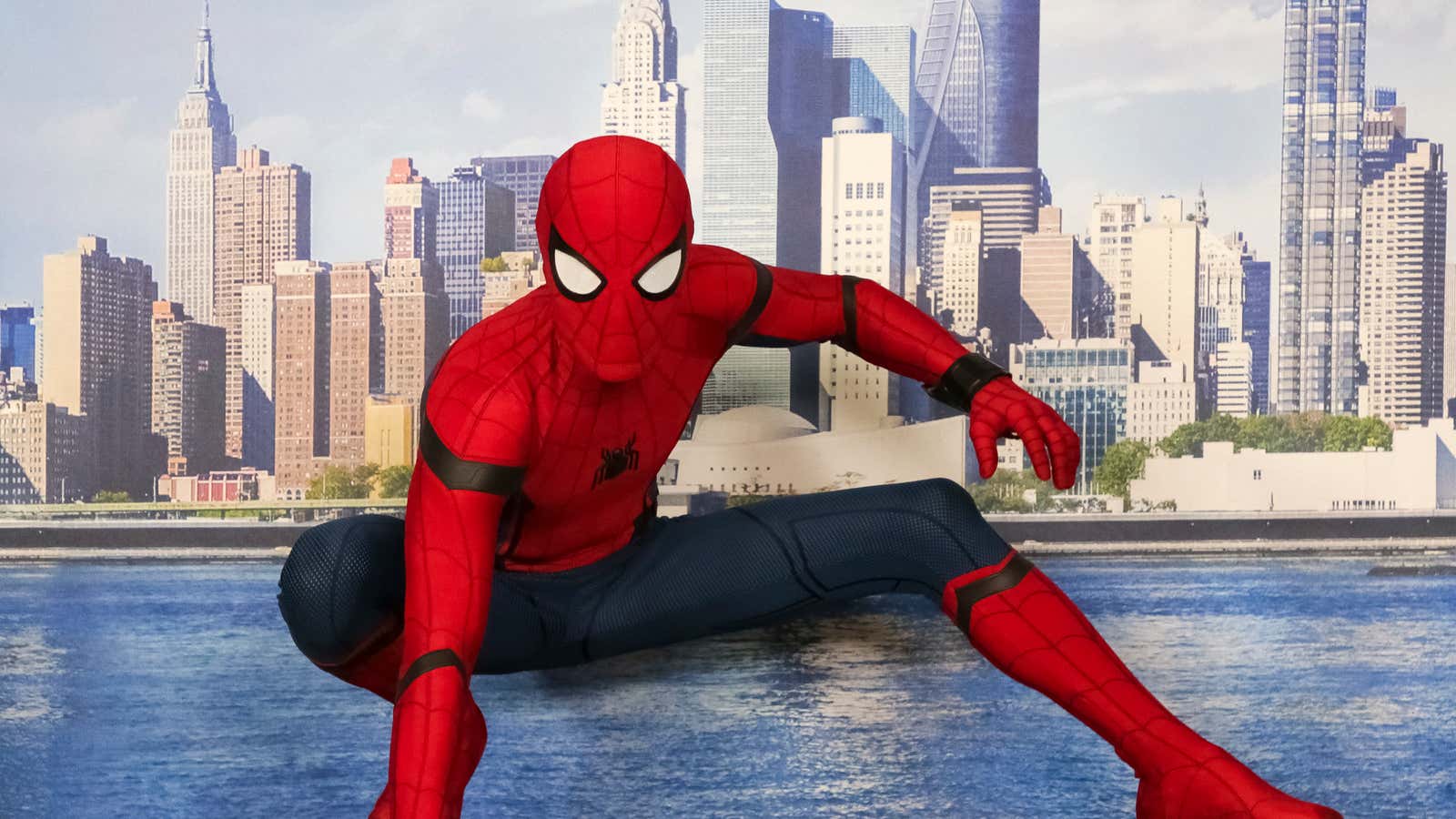Toward the end of Spider-Man:Homecoming, the movie introduces what it thinks is an exciting twist. “My friends call me MJ,” the character we’ve previously known as Michelle Jones announces.
This is what’s known as an Easter egg—a joke or bonus for devoted (and even for not so devoted) fans of a particular media property. MJ is the nickname of Mary Jane Watson, Peter Parker’s longtime romantic interest and sometimes wife in the Spider-Man comics. Giving Michelle the same initials tells you that she’s a potential romantic interest for Peter in the next film. Of course, that’s presuming you were staring into your popcorn for the entire preceding two hours of the movie, and therefore somehow needed a hint to let you know the pair had chemistry.
Easter eggs in superhero film and television shows are ubiquitous—nestled under practically every cape. Their purpose isn’t really to surprise fans, but to offer them a comforting dose of familiarity. Every Easter egg is a signal to viewers that the studios are attuned to and will remain faithful to the superhero canon. As such, they’re symbolic of a much bigger problem with contemporary entertainment: Mainstream movies and television keep trying to convince audiences that they’re innovating, when what they’re really doing is playing it safe. Show me an Easter egg, and I will show you a film that is aggressively proud of giving its viewers the same old content.
There’s nothing wrong with movies and TV shows referencing earlier art. Shakespeare recycled Ovid for A Midsummer’s Nights Dream. Jane Austen lifted the tropes of Gothic fiction for Northanger Abbey. De la Soul famously sampled Steely Dan. The difference, though, is that Shakespeare, Austen, and de la Soul include allusions because they want to take the art of the past and make something new. Shakespeare spins slapstick and ecstatic wordplay out of Ovid’s plot. Jane Austen mocks and undermines the conventions of the Gothic. De la Soul is both making fun of and celebrating Steely Dan by integrating the band’s so-uncool-it’s cool hook into its own, so-uncool-it’s-cool hip-hop collage. These artists aren’t just including earlier art to show that they know the art exists. They also have something new to say.
In contrast, as with Spider-Man’s MJ reveal, Easter eggs are generally unnecessary. They’re supposed to be. For example, Betty Brant, a love interest of Peter’s in the Spider-Man comics, gets a cameo in the movie as a news anchor on the high school’s closed-circuit television station. Nothing really happens with Betty; the reference is just there because the name “Betty Brant” has been used in the Spider-Man mythos before. Much of the film is little more than a series of coded messages especially designed for fans, and for journalists and bloggers at sites like the Hollywood Reporter assigned the Easter egg beat. Easter eggs don’t advance the plot; they’re an extra bonus for die-hards. They signal to those in the know that they are part of the in-crowd, steeped in the lore of nostalgia.
Easter eggs are also used as a lazy form of foreshadowing. Aaron Davis, a minor criminal played by Donald Glover in Spider-Man: Homecoming, is in the comics as the uncle of Miles Morales. Miles, in turn, takes over the mantle of Spider-Man in the Ultimate universe. And so the character of Aaron Davis is included to raise fans’ hopes that Morales, another familiar character, may turn up in later movies. The Easter egg is a promise of further Easter eggs to come. One corporate property is seeded to let you know that in the future, a thousand more corporate properties will bloom.
This isn’t to say that Easter eggs are always a dud. In Netflix’s Luke Cage, the titular hero (played by Mike Colter) escapes from prison and is forced to don a yellow, open-chested shirt and a tiara for lack of other clothes options. This is a reference to Luke Cage’s goofy superhero outfit in the comics—and I’ll admit I chuckled.
What makes that Luke Cage scene work, though, is that Cage himself seems aware of—and humorously disgusted by—the Easter egg reflected in the mirror. In part, the character’s reaction is Cage admitting to himself that he looks ridiculous. But it’s also Mike Colter, and the series itself, registering affectionate irritation with the fact that the show has to deal with the character’s less than illustrious past. It’s an Easter egg moment about being at least a little sick of Easter egg moments. “Do I really need to dress up like a fool just to let fans know that we validate their fandom?” Cage seems to be asking. “Well, okay, if I must. But the whole thing is kind of silly and embarrassing for everyone.”
Catering to a fan base isn’t evil. A little tingle of recognition can be fun. And if nostalgia properties showed up every now and again at the Cineplex, Easter eggs would be an occasional pleasure.
But when you’re eating Easter eggs at every meal, and tripping over piles of them scattered around the table as well, they stop being an entertaining novelty and start to become oppressive. Why can’t Michelle just be Michelle: a funny, nerdy, kid who cares about history and justice and is perceptive enough to know what’s going on with Peter? Why does she need “MJ” to tell us she’s a character worth being invested in? When we’re all so focused on collecting Easter eggs, we can forget that there are new treasures worth hunting.
